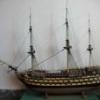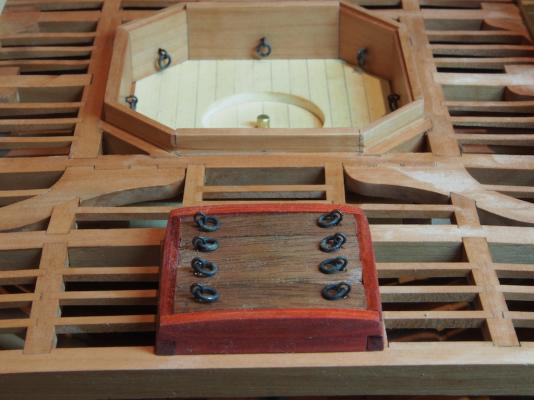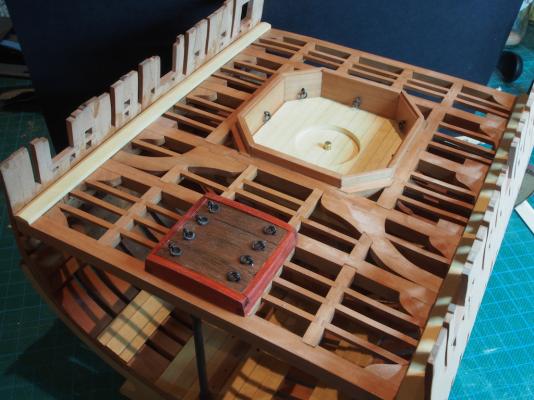-
Posts
4,888 -
Joined
-
Last visited
Content Type
Profiles
Forums
Gallery
Events
Everything posted by gjdale
-
We have an external hard drive, bought specifically for this purpose. Just need to convince the Admiral that she needs to move more of her movie collection to it.............. Yeah, I know, good luck with that!
- 456 replies
-
- finished
- bomb ketch
-
(and 2 more)
Tagged with:
-
Thanks Mike, I'll have another update soon but when I went to upload some photos today, I discovered that our hard drive is full (of downloaded movies). Will have to do some cleanup before posting - most likely next weekend.
- 456 replies
-
- finished
- bomb ketch
-
(and 2 more)
Tagged with:
-

The last video in my ...
gjdale replied to P_Budzik's topic in Painting, finishing and weathering products and techniques
Another excellent video Paul. Thank you for taking the time and effort to produce and share these - they are an excellent reference source and I have bookmarked all of them. -
The correctness of your decision on the planking is summed up beautifully in your statement: "Mrs Cathead likes it". What higher authority could there be?
-

Cutter Cheerful 1806 by rafine - FINISHED
gjdale replied to rafine's topic in - Build logs for subjects built 1801 - 1850
Your planking is looking very sharp there Bob.- 525 replies
-
- cheerful
- Syren Ship Model Company
-
(and 1 more)
Tagged with:
-
Looks like another fascinating project Dan - I'll follow along too.
- 108 replies
-
- andrea doria
- ocean liner
-
(and 1 more)
Tagged with:
-
Great to see you back in the shipyard Augie. She's looking mighty impressive.
- 2,191 replies
-
- confederacy
- Model Shipways
-
(and 1 more)
Tagged with:
-
Looking good Mobbsie. I'm glad you took a few progress shots here 'cause I forgot to!
- 255 replies
-
- granado
- bomb ketch
-
(and 2 more)
Tagged with:
-
Great job on the hull Nils, and congratulations on reaching the milestone of removing her from the board.
- 2,625 replies
-
- kaiser wilhelm der grosse
- passenger steamer
-
(and 1 more)
Tagged with:
-

replacement for blacken it brass?
gjdale replied to rtropp's topic in Metal Work, Soldering and Metal Fittings
For Brass, try Birchwood Casey Brass Black - usually available through gunsmith type shops and very good for brass. Or you might try Jax Pewter Black - usually available through jewellery supplies shops. The latter seems to be suitable for a wider range of metals, including white metal castings. I've just started using it and have been pretty happy with it. For Copper, try Liver of Sulfur (LoS) - get the gel version. The advantage of LoS is that it can be used in situ, without straining the surrounding timber. -
That looks good Kevin, and accurate. I'd stay with this method.
- 1,319 replies
-
- caldercraft
- Victory
-
(and 1 more)
Tagged with:
-
Great to see the repair job underway Mobbsie. It's a shame that it was needed, but as you say, an opportunity to improve on the original build. Love the new stand too!
- 21 replies
-
Thank you very much Larry, George and Christian.
- 456 replies
-
- finished
- bomb ketch
-
(and 2 more)
Tagged with:
-
Great work Danny. Glad to know the Jax Pewter Black arrived safely and seems to have worked very well for you.
-
Great to see you back Kevin and making some progress on your lovely Miss Vicky.
- 1,319 replies
-
- caldercraft
- Victory
-
(and 1 more)
Tagged with:
-
Thanks folks. Carl - I have no idea of the answer to that question. Perhaps one of our more knowledgeable brethren can answer that for us both.
- 456 replies
-
- finished
- bomb ketch
-
(and 2 more)
Tagged with:
-
Thanks once again for all the kind words folks and to all those who hit the "like" button. The Main Hatch The main hatch was a fairly simple construction using Redheart for the Coamings and Head Ledges, and Walnut for the Hatch Cover Boards. Templates were made from the drawings to assist with the lap joints and round up. Once the timber components of the hatch had been completed, two coats of Wipe-On Poly were applied to the Hatch, the Mortar Pit Housing and the deck frames on the Starboard side (which will not be planked). Lifting rings for both Mortar Pit Housing and the Main Hatch were made from brass wire formed around a drill bit, cut off with a rotary cutting disc and then soldered closed (I cheated and used a lead/tin soft solder). These were blackened chemically using a new (for me) product called Jax Pewter Black. Its claim is that it blackens all sorts of metals, including solder. After a bit of experimentation, I settled on diluting the solution 50/50 with distilled water, and after the usual cleaning process with vinegar and acetone beforehand, it seems to work fairly well. The same process was used to install lifting rings in the mortar pit housing. The Waterways were next to be tackled. These are made from boxwood and have two angled faces on the top side, which are not even. I thought about how to mill these for quite some time. After a tip from Danny, I tried to follow his technique of making a scraper from an old exacto chisel blade. Although I managed to make a reasonable shape for one angle, I couldn’t get an edge on it sufficient to scrape the timber. After some more thought, I marked out the profile along the length of the timber, and then used a couple of very small planes – one Veritas squirrel tail palm plane, and one even smaller Japanese finger plane. These worked a treat and the job turned out to be much easier than I had expected. Here’s a couple of pictures showing the current state of play.
- 456 replies
-
- finished
- bomb ketch
-
(and 2 more)
Tagged with:
-
Nice to see another of your Woody Joe kits Clare. I like the look of these.
- 106 replies
-
- Japanese boat
- Wasen
-
(and 2 more)
Tagged with:
-

How would you improve your Byrnes tools?
gjdale replied to Keith_W's topic in Modeling tools and Workshop Equipment
Thanks Danny for the much needed guidance. Keith - sorry for hijacking your thread. Let's now resume normal programming.
About us
Modelshipworld - Advancing Ship Modeling through Research
SSL Secured
Your security is important for us so this Website is SSL-Secured
NRG Mailing Address
Nautical Research Guild
237 South Lincoln Street
Westmont IL, 60559-1917
Model Ship World ® and the MSW logo are Registered Trademarks, and belong to the Nautical Research Guild (United States Patent and Trademark Office: No. 6,929,264 & No. 6,929,274, registered Dec. 20, 2022)
Helpful Links
About the NRG
If you enjoy building ship models that are historically accurate as well as beautiful, then The Nautical Research Guild (NRG) is just right for you.
The Guild is a non-profit educational organization whose mission is to “Advance Ship Modeling Through Research”. We provide support to our members in their efforts to raise the quality of their model ships.
The Nautical Research Guild has published our world-renowned quarterly magazine, The Nautical Research Journal, since 1955. The pages of the Journal are full of articles by accomplished ship modelers who show you how they create those exquisite details on their models, and by maritime historians who show you the correct details to build. The Journal is available in both print and digital editions. Go to the NRG web site (www.thenrg.org) to download a complimentary digital copy of the Journal. The NRG also publishes plan sets, books and compilations of back issues of the Journal and the former Ships in Scale and Model Ship Builder magazines.




